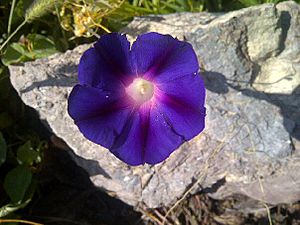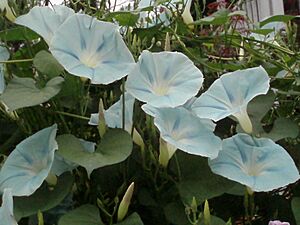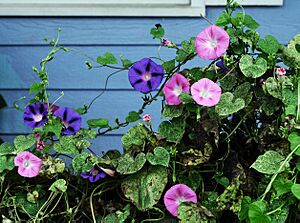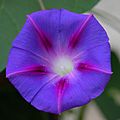Morning glory facts for kids
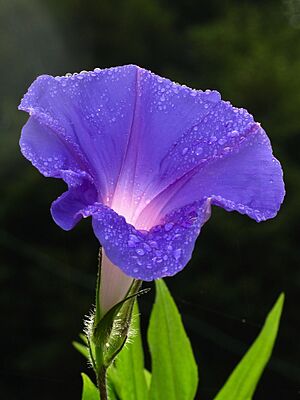
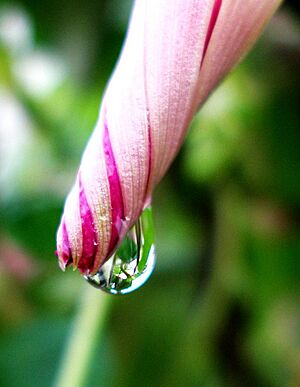
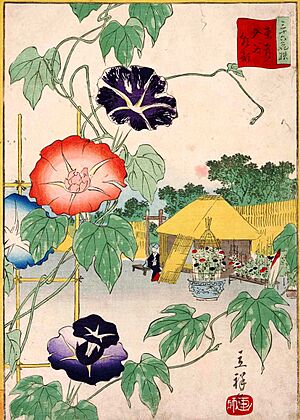
Morning glory is a common name for over 1,000 different kinds of flowering plants. These plants belong to the Convolvulaceae family. Morning glories are found in many different plant groups, called genera. Some of these include:
- Argyreia
- Calystegia
- Convolvulus
- Ipomoea
- Merremia
Contents
What Are Morning Glories Like?
Most morning glory flowers open up fully in the early morning. They usually start to close up a few hours later, before their petals begin to curl. These plants love lots of sunshine all day long. They also like moist soil. Some morning glories, like Ipomoea muricata, bloom at night instead of in the morning.
In some places, like the Australian bush, certain morning glory types can grow very thick roots. They often form dense patches. They spread quickly using long, creeping stems. Because they grow so fast and cover other plants, morning glories can become a serious invasive weed problem. This means they can take over areas and harm other plants.
Growing Morning Glories
In gardens, most morning glories are grown as perennial plants in warm places where it doesn't freeze. This means they grow back year after year. In colder areas, they are grown as annual plants, meaning they live for only one growing season. However, some types can handle cold winters. Some species are always annuals, like I. nil, and produce many seeds. Other perennial types, like I. indica, can be grown from cuttings. Some moonflowers, which bloom at night, are also part of the morning glory family.
Morning glories grow very fast and can climb well. They have pretty flowers and can grow in poor, dry soil. This makes them great vines for creating summer shade on building walls if you give them something to climb on, like a trellis. This can help keep buildings cooler and save energy.
Some popular types grown today include 'Sunspots', 'Heavenly Blue', the moonflower, the cypress vine, and the cardinal climber. The cypress vine is a mix of two plants, with the cardinal climber as one of its parents.
Many morning glories will plant their own seeds in the garden. Their seeds have a hard outer shell, which can make them take longer to sprout. You can help them sprout faster by soaking them in warm water before planting.
History of Morning Glories
Morning glories were first known in China. People used them for medicinal purposes because their seeds had properties that helped with digestion.
In the 9th century, morning glories were brought to Japan. The Japanese were the first to grow them as pretty flowers. During the Edo period, they became very popular. Japan has been a leader in creating many new types of morning glories. Hundreds of varieties have been developed, like a brownish one called Danjuro. There are also types with names like 'Brocade of Dawn' and 'Wisteria Girl'. Morning glories have become a symbol of summer in Japanese gardens and art.
Ancient civilizations in Mesoamerica used a morning glory species called Ipomoea alba. They used its juice to help turn latex from the Castilla elastica tree and the guayule plant into bouncy rubber balls. The juice from the morning glory helped make the rubber stronger. This process happened at least 3,000 years before a man named Charles Goodyear discovered a similar method.
Ipomoea aquatica, also known as water spinach, is a type of morning glory. It is often used as a green vegetable, especially in East and Southeast Asian cuisines. In the USA, growing or selling Ipomoea aquatica can be against the law without a special permit. This is because it is considered a plant that could harm local ecosystems. However, it is a very popular vegetable in many cultures. The state of Texas has allowed water spinach to be grown for personal use, as it has been grown there for many years without causing problems.
The Ipomoea group also includes the sweet potato (Ipomoea batatas). Even though we don't usually call sweet potatoes "morning glories," sometimes they are called "tuberous morning glories" by gardeners. Some types of sweet potatoes are grown for their beautiful leaves and vines, not just for their edible roots.
Gallery
-
A fully open blue and purple morning glory (Ipomoea purpurea)
Images for kids
-
Blue morning glory flower (Ipomoea indica)


